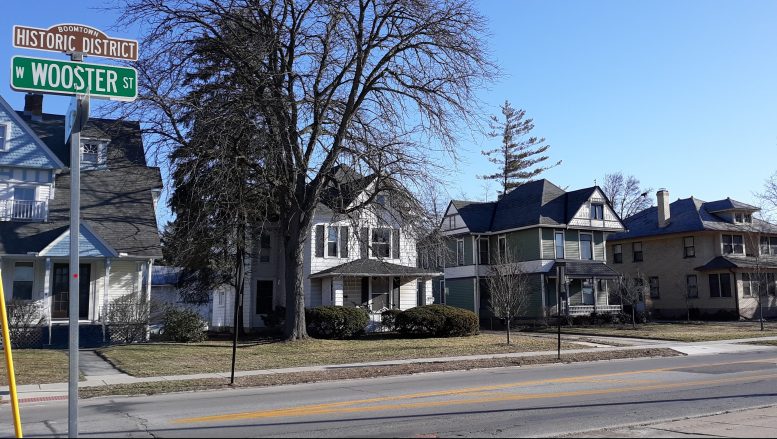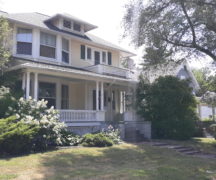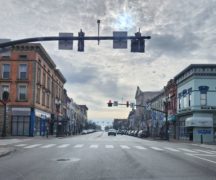By JAN LARSON McLAUGHLIN
BG Independent News
Timing is everything. And once again, efforts to create a historic preservation plan for Bowling Green will be slowed – this time due to COVID-19.
For the past 18 months, the city’s resurrected Historic Preservation Commission has been fine-tuning a proposal for the older, often architecturally ornate parts of the city.
The commission has been working to debunk myths about historic preservation rules that doomed the first effort about six years ago.
The commission’s goal is to “preserve, promote, encourage and support the maintenance, use and reuse of historic buildings in the city.” In other words, it would help property owners who want to preserve historic structures.
Some historic homes are losing the battle against time and rental transformation. And the longer the preservation efforts are on hold, the more some structures deteriorate.
But last week, as the commission prepared to send its proposal to City Council, members debated whether this was the time to move forward.
“I’m just not comfortable that now is the time to ask them to buy into something else,” commission member John Wade said about downtown businesses that may already be struggling under the weight of the pandemic.
The same concerns exist for local homeowners, commission President Gail Nader said. “The stresses on families” are great right now, she said.
Mayor Mike Aspacher agreed – though stressed that his desire to delay the plan has nothing to do with a lack of support.
“I remain committed to it,” he said. “But timing is very important.”
Introducing a detailed historic preservation plan, getting community support, and implementing preservation efforts now – during a pandemic – may not be the best route to success, the mayor said.
“It’s always more important to get it right than to get it quick,” Aspacher said.
So the commission – made up of Nader, Wade, Les Barber, John Sampen and Wil Roudebush – decided to spend the time during the pandemic coming up with a concise presentation on the historic preservation plans and gathering public input.
The next step in the process is getting City Council to adopt a historic preservation ordinance, according to City Planning Director Heather Sayler. But the commission acknowledged that its pitch to council needs to be fine-tuned. Public hearings will be required.
From there, it will be up to City Council to apply to be a Certified Local Government, which will allow for a historic preservation plan to be implemented.
Then, the historic overlay zoning districts will be created – if the majority of the property owners support the idea.
Since the pandemic isn’t allowing large public meetings right now, Barber suggested that small groups be engaged on the proposal.
The commission stressed that owners of historic properties will not be told what to do with their homes or businesses.
“We have an ordinance that is going to help them, not hurt them,” Nader said.
Rather than creating long lists of specific recommendations, the commission agreed to use guidelines recommended by the Secretary of Interior for the treatment of historic properties.
“It’s not dictatorial,” Sampen said.
“We’re not making them paint their door knocker purple,” Nader said as an example.
The proposal for the historic preservation commission was first brought up in 2009, then became part of earnest discussions in 2013. Efforts died in 2015 after some citizens interpreted the city’s preservation efforts as government telling them what to do with their properties.
At that time, Mayor Dick Edwards tried to explain that the commission was there to help – not give orders.
Nevertheless, suspicions and very vocal objections by a few citizens about the motivation for the historic preservation commission killed the effort.
This time around, the city and the commission members hope to do a better job of educating the public and calming fears.
The goal of historic preservation is to protect the historic integrity of buildings – and help when possible with restorations. It is not to nitpick and tell homeowners what they can and cannot do with their properties.
Three sites and two historic districts in Bowling Green are currently listed on the National Register of Historic Places by the Secretary of the Interior upon recommendation of the Ohio Historic Preservation Office. However, placement on the National Register provides no protection to any historic property.
To fully function, the commission would need to apply to become a Certified Local Government through the Ohio Historic Preservation Office. The CLG status would allow the city to get preservation grants and tax credits to help homeowners and businesses protect historic buildings.
More than 70 cities and political bodies in Ohio are already working with the state to address historic preservation. Cities like Toledo, Akron and Tiffin are taking advantage of preservation tax credits to rebuild central city business districts and enhance property values in historic neighborhoods.





